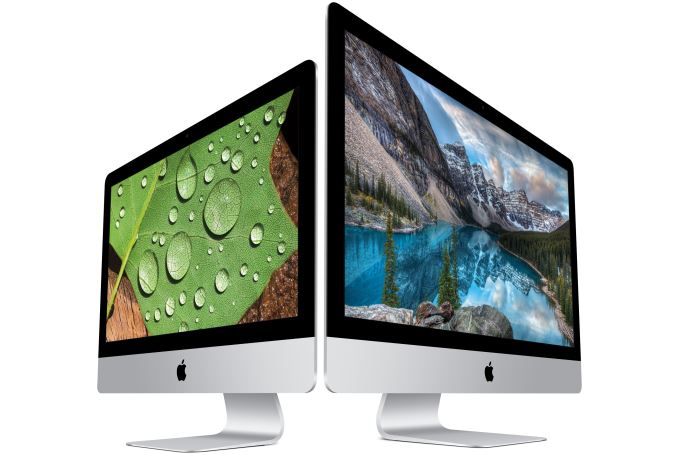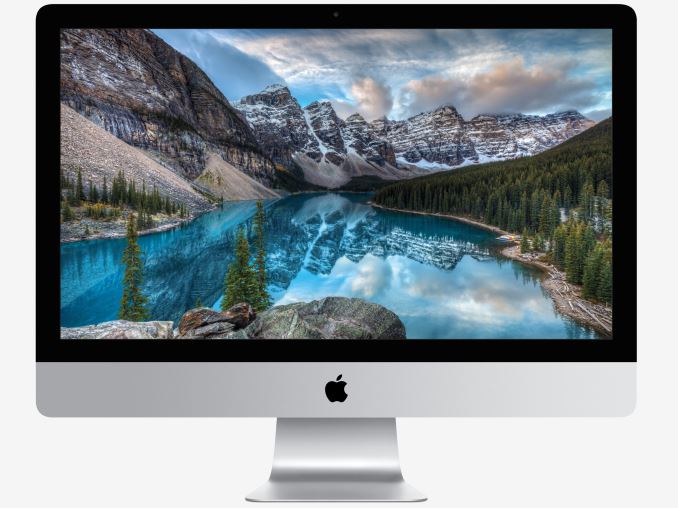Apple Updates The iMac Line With a 21.5" Retina Model
by Brandon Chester on October 13, 2015 10:55 AM EST
Almost exactly one year ago Apple launched their first ever iMac with Retina display at their October 2014 event. The launch had a number of surprises, with one of the biggest being the fact that it would sell for $2499 despite its 5K display matching the resolution of Dell's UP2715K which had an intended launch price of $2999. While Apple doesn't appear to be planning any more events for this year, they have decided to ship an upgrade to their existing 27" iMac with 5K Retina display, and have also introduced a brand new 21.5" iMac with Retina 4K Display. You can view the specs for the base models of Apple's new 2015 iMacs in the chart below.
| Apple iMac With Retina Display 2015 | ||||
| Model | 21.5" Base | 27" Base | ||
| CPU | 3.3GHz Core i5-5675C/R (Broadwell) |
3.5GHz Core i5-6500 (Skylake) |
||
| GPU | Intel Iris Pro 6200 | AMD Radeon R9 M380 (2GB) | ||
| Display | 21.5" 4096 x 2304 IPS LCD | 27" 5120 x 2880 IPS LCD | ||
| Memory | 8GB 1867MHz DDR3 (LPDDR3 in 21.5") | |||
| Storage | 1TB 5400RPM HDD | 1TB 7200RPM HDD | ||
| Price | $1499 | $1799 | ||
Just briefly touching on the 27" iMac, it's mainly an upgrade to the internal hardware from its original Intel Haswell platform. The CPU in the base model is now a 3.5GHz quad core i5-6500 which is an Intel Skylake part, and the upgraded options include a 3.3GHz i5-6600 and what is seemingly the 4.0GHz i7-6700K which would typically be an unlocked part, although I wouldn't expect any overclocking to be accessible. The GPU is now AMD's R9 M380. The GPUs also move to AMDs M300 series, with an M380 in the base model, an M390 in the mid tier, and an M390X in the high end model, all with 2GB of GDDR5 memory. There's also the M395X with 4GB of GDDR5 memory available as a BTO option.
The 21.5" iMac is the most interesting of the two new devices purely due to it being a brand new machine. Apple calls it the iMac with 4K Retina display, and it means that there are now Retina display options for both display sizes of the iMac. Speaking of the display, it's a 21.5" 4096 x 2304 IPS panel, which is higher than the 3840 x 2160 UHD resolution shipping on most "4K" displays, and it has enough horizontal and vertical resolution to natively display actual DCI 4K content.
In addition to the 21.5" model's new HiDPI display, both models of the iMac receive a boost to their color gamuts. Apple is now claiming support for the DCI-P3 gamut which is used in digital projection movie theaters, and this has been achieved by moving from a WLED backlight array to something similar to GB-r LEDs in order to increase the range of spectral emissions. What will be interesting to see is if Apple allows users to revert to the sRGB color space, which would require the inclusion of a 3D LUT that could also be used for more accurate self-calibration than the past.
I do question the choice of DCI-P3 over Adobe RGB though. Apple claims that most cameras can capture a wider color range than sRGB, which is true, but in my experience they'll usually only offer Adobe RGB as the other option. The DCI-P3 gamut is more similar to Adobe RGB than sRGB is, but it's definitely not the same and so there will be some error there when working in Adobe RGB without the correct gamut on the display. That being said, the fact that both displays can natively display DCI 4K content means they could theoretically be used for video editing, but I question the viability of mastering films for cinema projection with the processing power available in an iMac.
Beyond the display, the 21.5" iMac with 4K Retina display seems to stick with Intel's Broadwell platform rather than Skylake, as Apple needs to ship a part with Iris Pro graphics in order to drive the display. The CPU used is the 3.3GHz i5-5675C/R, with it being unclear whether it's the C or the R SKU which would mean a socketed or a BGA CPU respectively. I doubt many people would be adventurous enough to open up the chassis and replace the CPU even if it was possible anyway.
Apple has also brought down the cost of the Fusion Drive upgrade, but it comes with a sacrifice. The 1TB Fusion Drive now only has a 24GB flash memory segment, while it was previously 128GB. Both the 2TB and 3TB Fusion Drive options still come with 128GB of flash storage. While the 1TB Fusion Drive may still be worth it on the 21.5" iMac purely due to how slow 5400RPM HDDs are, it's hard to stomach paying $100 for 24GB of NAND, and I would definitely just stick with the standard HDD if I were buying the base model 27" iMac.
Both new Retina iMacs are available for purchase on the Apple Online Store, with shipping times as early as one business day. BTO configurations will obviously take longer depending on which customizations are chosen. The 21.5" iMac with 4K Retina display starts at $1499. The 27" iMac with 5K Retina Display starts at $1799, with the 3.2GHz R9 390M + 1TB Fusion Drive model at $1999 and the high end 3.3GHz i5, R9 M395 + 2TB Fusion Drive model at $2299.











46 Comments
View All Comments
Kjella - Tuesday, October 13, 2015 - link
A display that happens to show DCI 4K natively pixel for pixel and paired with a DCI-P3 gamut, you don't have to be a rocket scientist to figure out why. Occasionally Apple still throws the professional market a bone, there's plenty other offers targetting photographers.Brandon Chester - Tuesday, October 13, 2015 - link
The iMac is a much better device for photo editing than it is for video editing purely due to the processing power available. If I had to choose one way or the other I would have opted for AdobeRGB.ltcommanderdata - Tuesday, October 13, 2015 - link
Semi-seriously, Apple might have just preferred the colour space that didn't require them to put "Adobe" in all their marketing material.More seriously, aren't iPhones the most popular photo and video cameras in terms of amount of content produced? Adobe RGB may be the most popular wide gamut colour space right now, but that usage is probably still a small fraction of sRGB. If Apple put DCI-P3 cameras and screens in the next iDevices and enabled them by default and other smartphone makers followed it wouldn't be long before DCI-P3 becomes the default wide gamut standard for photography.
nathanddrews - Tuesday, October 13, 2015 - link
Nothing stops anyone from taking the raw images (devoid of any color space) and bringing them into DCI-P3, except that no website or commercial printer will use it. It'll just get converted to sRGB anyway.Spoony - Tuesday, October 13, 2015 - link
It's not a move that was designed to serve the pro audience (if it was it would have been Adobe RGB). It caters purely to improving the display quality for their standard consumer. I think Apple made the right call here, although I have mixed feelings about them running off and doing their own thing yet again.I use a calibrated Adobe RGB display daily for photo and other media work. Most photos I take do not reach into the very upper registers of green gamut. While certainly they are in excess of sRGB, the section of greens not covered by DCI-P3 are not the most critical day to day greens. However, a much larger number of photos I work with have deep reds/yellows which are better represented by DCI-P3. Further P3 is simply a larger gamut, not by much, but by a bit. These are simply my experiences, perhaps you work with lots of far reaching greens.
However, the DCI spec also calls for a gamma of 2.6. I must assume Apple has stuck to 2.2 native and are simply using the P3 color space.
blackcrayon - Tuesday, October 13, 2015 - link
The CPU is no slouch though, it's not like you *need* a dual socket machine or more than 4 cores for video editing. And it has potentially extremely fast I/O.id4andrei - Wednesday, October 14, 2015 - link
OSX still can't do 10 bit and neither can their displays, DCI enabled or not.magreen - Tuesday, October 13, 2015 - link
I have a hard time comprehending how anyone could tolerate a HDD at whatever RPM in these otherwise high-end machines. I think I am typical in being accustomed to SSDs in all my machines--even budget ones, and even in the laughable 2011-era ultrabook they give me to use at work.TEAMSWITCHER - Tuesday, October 13, 2015 - link
A very good point. The 21" 4K iMac should have come standard with a fusion drive. Actually, I'd like to see Apple remove spinning disks from their whole line-up. If I need slow mass storage, I'll hang a USB Drive off the back or buy a NAS.nerd1 - Tuesday, October 13, 2015 - link
It's almost 2016 and 5400rpm HDD in $1499 device? Do they even have m2 slot at all? LOL